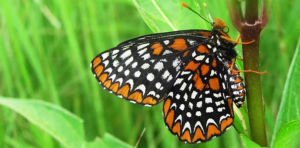Operation Checkerspot
The crunch, crunch, crunch of brittle snow underfoot is all I hear as we make our way along an agricultural ditch. In the southeast sky, the orange ball of the sun is breaking the ridgetop’s crest, but the frigid January air robs us of its warmth. I’m inspecting rows of large box elder trees leaning precariously over the ditch, which the landowner wants removed. Some had previously toppled over, exposing organic soil in their head-high tangle of roots. Not worth it, I think, questioning the ecological benefits of this project. Unexpectedly, I spot some peculiar-looking dried plant stalks sticking out of the snow in a small opening free of the invasive species reed canary grass. I can’t believe it.
I walk out of the canary grass towards the dried plant stalks in the small opening and find myself stumbling over tussocks hidden beneath the snow. Excited, I realize I’m standing in a remnant wetland about a half-acre in size. And even better, I discover, the dried plant stalks are turtlehead plants. Is it even possible, I wonder? I’ll have to get back here in June.
The following June, after receiving permission from the landowner, I’m back in the little remnant wetland and am delighted. The wetland is surprisingly high-quality with many species of native sedges and forbs (flowers) present. But I’m here today hoping for a long shot. I’m looking for a critter whose very existence depends almost exclusively on the turtlehead plant.
My eyes scan across the top of the wetland vegetation looking for a flash of movement with the colors of orange, white and black. Nothing. I carefully navigate around dozens of large tussock sedges, pause briefly to admire a patch of marsh marigolds, and then strategically locate myself where I have a commanding view of the entire wetland.
I wait. Minutes pass before I notice a medium-size butterfly peacefully perching on a nearby sedge leaf. Excited, I slowly raise my binoculars to focus on the butterfly. What incredible luck, I think. I’ve found what I’ve come for. I’m looking at a Baltimore checkerspot butterfly. Its beauty is just breathtaking with rows of orange and white dots overlaid on black wings. And, what I find most charming, is the little orange ball (called an antenna club) at the tip of each antenna.

According to the Maryland DNR, the Baltimore checkerspot is named after George Calvert, the first Lord Baltimore, because its orange and black colors match those on his heraldic shield. In 1973, the Baltimore checkerspot was named the official insect of Maryland. Today, unfortunately, this butterfly is rare in Maryland and other parts of its range due to habitat loss and degradation.
One of the reasons this butterfly is so rare is because it’s a specialist and will only lay its eggs on the native turtlehead plant. And, as you might expect, turtlehead plants aren’t common either. I only see them in high-quality wetlands, which are few in southern Wisconsin due to habitat loss from agriculture and invasive species encroachment.
According to the Chicago Academy of Sciences/Peggy Notebaert Nature Museum, the lifecycle of the Baltimore checkerspot is as follows: In June/July female butterflies lay eggs on the native turtlehead plant. In the summer, caterpillars build a communal web where they will live and feed together. They eat a narrow range of plants that include turtlehead, swamp betony and valerian. Throughout the summer, the web grows lower and lower, eventually reaching the ground. The caterpillars become dormant and enter a hibernation-like state by late fall. This is where they spend the winter. In early spring, the caterpillars wake up and begin feeding again for a few weeks. By late spring, the caterpillars will each form a chrysalis. Two weeks later, in late May/June, the adult butterflies will emerge.
Hours after my encounter with the Baltimore checkerspot in the small wetland, I’m walking down our driveway to get the mail and to my amazement find a Baltimore checkerspot butterfly resting on the gravel. Did this little guy follow me home? I wonder. After all, that little wetland in not far from here as the crow (or butterfly) flies.
My mind races. The little wetland is in peril given it is totally surrounded by the invasive reed canary grass, and I only found two turtlehead plants during my visit. What if we can get a checkerspot population established here before its habitat is all gone in the nearby little wetland? We have good restored habitat with lots of swamp betony and nectar plants such as marsh milkweed. We just need to get turtlehead established.
With that, we launch Operation Checkerspot. We bought two dozen turtlehead plants from a local native plant nursery and planted them in four groupings of six in two reconstructed wetlands. We caged them from the deer, and a year later, we were able to collect turtlehead seed from a local high-quality wetland.
Today, four years later, we are still waiting for the Baltimore checkerspots to appear. We had many blooming turtlehead plants this past season, and their numbers continue to expand. Soon, we hope, we can collect the turtlehead seed and introduce them in another reconstructed wetland on our property. With the increasing population of turtlehead and swamp betony plants and large number of nectar plants, the habitat seems prime for Baltimore checkerspots.
But were our actions too little too late? Has the checkerspot disappeared forever in the nearby little wetland? The colors of Lord Baltimore’s heraldic shield no longer dancing over the summertime flowers.
Ecological restoration is a long, hard road. We make progress down this road utilizing little bits of knowledge and a lot of hope.
I’ve thought about going back to that small wetland for another look, but quickly push the thought aside, rationalizing that it will prove nothing.
Perhaps though, I don’t really want to know the answer.
Originally published in Environmental Returns.


